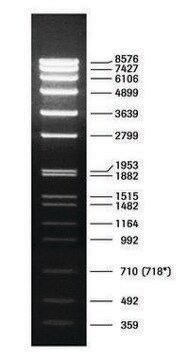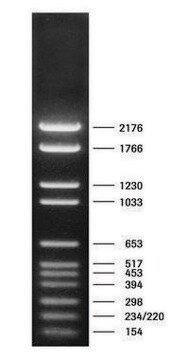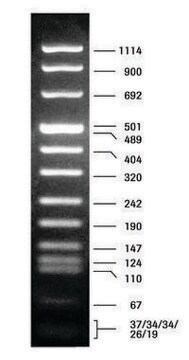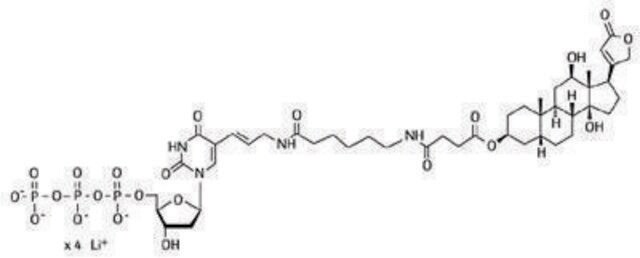11669940910
Roche
Marker masy cząsteczkowej DNA VII, znakowany DIG
Synonim(y):
Marker DNA
About This Item
Polecane produkty
Formularz
solution
Poziom jakości
opakowanie
pkg of 500 μL (10 μg/ml)
producent / nazwa handlowa
Roche
charakterystyka ekologicznej alternatywy
Designing Safer Chemicals
Learn more about the Principles of Green Chemistry.
sustainability
Greener Alternative Product
stężenie
10 μg/mL
kolor
colorless
rozpuszczalność
water: miscible
kategoria ekologicznej alternatywy
temp. przechowywania
−20°C
Opis ogólny
DNA Molecular Weight Marker VII, DIG-labeled is a ready-to-use solution in 10mM Tris-HCl, 1mM EDTA, pH 8.0. The fragment mixture is prepared by cleavage of SPP1 DNA with EcoRI. the size ranges from 0.081 to 8.57kbp.
Zastosowanie
Sekwencja
Note: Fragment lengths are derived from computer analysis of the DNA sequence. Depending on the size range of the marker, the smallest fragments will only be visible on overloaded gels.
Inne uwagi
Kod klasy składowania
12 - Non Combustible Liquids
Klasa zagrożenia wodnego (WGK)
nwg
Temperatura zapłonu (°F)
No data available
Temperatura zapłonu (°C)
No data available
Wybierz jedną z najnowszych wersji:
Masz już ten produkt?
Dokumenty związane z niedawno zakupionymi produktami zostały zamieszczone w Bibliotece dokumentów.
Klienci oglądali również te produkty
Produkty
Digoxigenin (DIG) labeling methods and kits for DNA and RNA DIG probes, random primed DNA labeling, nick translation labeling, 5’ and 3’ oligonucleotide end-labeling.
Metody znakowania digoksygeniną (DIG) i zestawy do sond DNA i RNA DIG, znakowanie DNA z losowym primerem, znakowanie nickiem translacyjnym, znakowanie końcowe oligonukleotydów 5' i 3'.
Nasz zespół naukowców ma doświadczenie we wszystkich obszarach badań, w tym w naukach przyrodniczych, materiałoznawstwie, syntezie chemicznej, chromatografii, analityce i wielu innych dziedzinach.
Skontaktuj się z zespołem ds. pomocy technicznej





